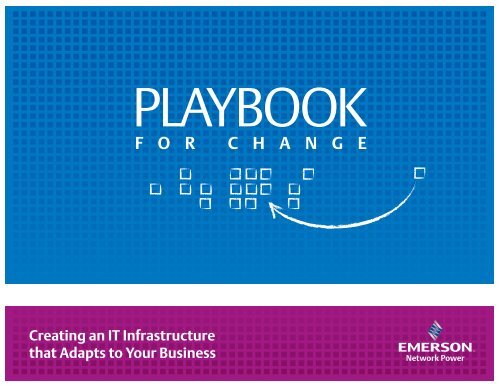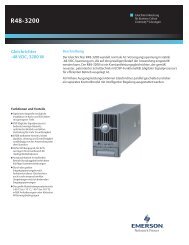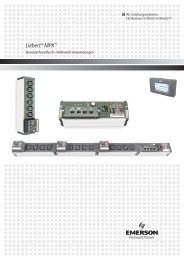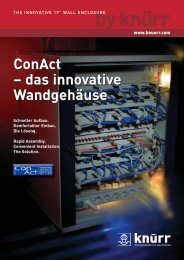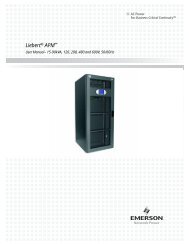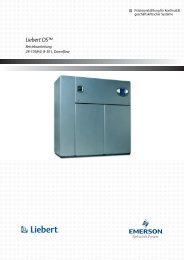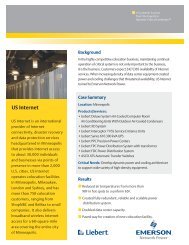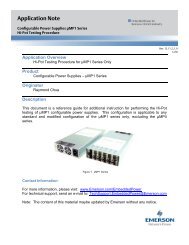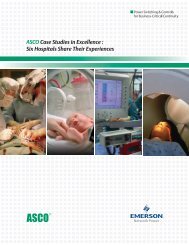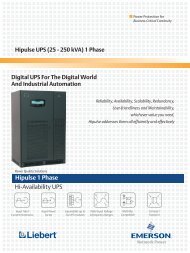Creating an IT Infrastructure that Adapts to Your Business - Emerson ...
Creating an IT Infrastructure that Adapts to Your Business - Emerson ...
Creating an IT Infrastructure that Adapts to Your Business - Emerson ...
Create successful ePaper yourself
Turn your PDF publications into a flip-book with our unique Google optimized e-Paper software.
<strong>Creating</strong> <strong>an</strong> <strong>IT</strong> <strong>Infrastructure</strong><br />
<strong>that</strong> <strong>Adapts</strong> <strong>to</strong> <strong>Your</strong> <strong>Business</strong><br />
PLAYBOOK<br />
F O R C H A N G E
<strong>Creating</strong> <strong>an</strong> <strong>IT</strong> <strong>Infrastructure</strong> <strong>that</strong> <strong>Adapts</strong> <strong>to</strong> <strong>Your</strong> <strong>Business</strong><br />
For decades, data centers have been over-provisioned<br />
two or even three times over in <strong>an</strong> attempt <strong>to</strong> “pl<strong>an</strong>”<br />
for growth. <strong>Business</strong>es have spent excessively <strong>to</strong> build<br />
facilities <strong>that</strong> might be able <strong>to</strong> h<strong>an</strong>dle potential <strong>IT</strong><br />
needs <strong>that</strong> may arise sometime in <strong>an</strong> uncertain future.<br />
As recently as 10 years ago, before virtualization was<br />
widely accepted, it was not unusual <strong>to</strong> see 4 watts of<br />
UPS capacity installed for every 1 watt of <strong>IT</strong> load. To<br />
be fair, 10 years ago <strong>that</strong> may have been the only<br />
guar<strong>an</strong>teed way <strong>to</strong> ensure the investment in <strong>IT</strong><br />
resulted in the needed capacity increases – even if<br />
<strong>that</strong> investment amounted <strong>to</strong> a massive overpay.<br />
That isn’t the case <strong>to</strong>day, although limitations <strong>to</strong> the<br />
physical infrastructure – power, cooling <strong>an</strong>d space –<br />
remain. Now, instead of bumping up against imagined<br />
walls like some overzealous mime, data center<br />
m<strong>an</strong>agers <strong>an</strong>d CIOs c<strong>an</strong> measure their loads <strong>an</strong>d<br />
capacity accurately, <strong>an</strong>d deploy techniques <strong>an</strong>d technologies<br />
<strong>to</strong> either maximize or add capacity without<br />
the massive capital investment <strong>that</strong> comes with a new<br />
data center – or be armed with enough data <strong>to</strong> go in<strong>to</strong><br />
a new build confident it’s the right choice.<br />
But with a whole spectrum of choices available – up<br />
<strong>to</strong> <strong>an</strong>d including biting the bullet <strong>an</strong>d building a<br />
shiny new data center – how do forward-thinking,<br />
budget-conscious businesses make the right choice?<br />
How do they build <strong>an</strong> <strong>IT</strong> infrastructure <strong>that</strong> c<strong>an</strong> scale<br />
in every direction in order <strong>to</strong> meet uncertain future<br />
dem<strong>an</strong>ds?<br />
2018 or beyond (6+ years)<br />
2017 (5 year)<br />
2016 (4 year)<br />
2015 (3 year)<br />
2014 (2 year)<br />
2013 (1 year)<br />
2012<br />
7.3%<br />
0.0% 5.0% 10.0% 15.0% 20.0% 25.0%<br />
Increasing power densities are going <strong>to</strong> stretch the power <strong>an</strong>d cooling capacity of m<strong>an</strong>y existing data centers. This chart<br />
shows when surveyed data center m<strong>an</strong>agers expect <strong>to</strong> be impacted by data center capacity constraints. (Source: Data<br />
Center Users’ Group Fall 2012 Survey)<br />
Know the Scouting Report<br />
The formula for <strong>an</strong>y decision in the data center is<br />
well-established: bal<strong>an</strong>ce capital <strong>an</strong>d operational<br />
expenses as efficiently as possible without<br />
jeopardizing availability of critical applications.<br />
Simply put, minimize capital investments unless<br />
the investment will be recovered through a reduction<br />
in operational expenses. Recovery could happen in<br />
<strong>an</strong>y number of ways. For example, it could happen<br />
by increasing capacity <strong>an</strong>d, in turn, business volume<br />
<strong>an</strong>d revenue. Or by increasing energy efficiency <strong>an</strong>d<br />
reducing operational costs related <strong>to</strong> power<br />
consumption. Or by reduction or elimination of<br />
ongoing mainten<strong>an</strong>ce <strong>an</strong>d service. In each case,<br />
it comes down <strong>to</strong> a cost-benefit <strong>an</strong>alysis.<br />
10.4%<br />
11.0%<br />
12.2%<br />
17.1%<br />
20.1%<br />
22.0%<br />
A few questions c<strong>an</strong> help establish a basic strategy<br />
for m<strong>an</strong>aging org<strong>an</strong>izational growth <strong>an</strong>d increasing<br />
<strong>IT</strong> dem<strong>an</strong>d. Those questions are:<br />
Is the entire load critical <strong>to</strong> the business?<br />
The kneejerk reaction is “yes.” And in some cases –<br />
fin<strong>an</strong>cial services institutions or ecommerce businesses,<br />
for example – <strong>that</strong> may be true. But even in those<br />
examples, a closer examination may reveal a different<br />
<strong>an</strong>swer. Ensuring availability of all tr<strong>an</strong>sactional functions<br />
is non-negotiable, but what about some internal <strong>IT</strong><br />
functions or support systems? If some applications<br />
are less critical, could they be outsourced <strong>to</strong> a<br />
co-location facility or hosted in the cloud? If so,<br />
<strong>that</strong> frees up capacity within the owned data center.<br />
1
<strong>Creating</strong> <strong>an</strong> <strong>IT</strong> <strong>Infrastructure</strong> <strong>that</strong> <strong>Adapts</strong> <strong>to</strong> <strong>Your</strong> <strong>Business</strong><br />
Even within the data center, some org<strong>an</strong>izations are<br />
beginning <strong>to</strong> assign non-critical applications <strong>to</strong><br />
separate pods with a less robust infrastructure <strong>an</strong>d<br />
adjusting the expectations for availability accordingly.<br />
The savings generated in those non-critical pods c<strong>an</strong><br />
be used elsewhere – including reinvestment in the<br />
infrastructure in more critical areas supporting<br />
high-value applications.<br />
Is there available infrastructure capacity <strong>that</strong><br />
isn’t being used?<br />
This seemingly simple question tends <strong>to</strong> confound<br />
even the most <strong>IT</strong>-focused org<strong>an</strong>izations. Data centers<br />
grow <strong>an</strong>d evolve over time, adding servers <strong>an</strong>d the<br />
power <strong>an</strong>d cooling needed <strong>to</strong> support them – <strong>an</strong>d<br />
all of those additions consume valuable space. The<br />
facility may or may not be virtualized – a practice<br />
<strong>that</strong> c<strong>an</strong> increase efficiency but c<strong>an</strong> complicate the<br />
capacity question. Eventually trying <strong>to</strong> figure out<br />
exactly what the existing infrastructure c<strong>an</strong> support<br />
becomes more difficult th<strong>an</strong> it should be.<br />
Data Center<br />
Availability<br />
<strong>Infrastructure</strong> Tier Description Supported<br />
I: Basic Data Center<br />
II: Redund<strong>an</strong>t<br />
Components<br />
III: Concurrently<br />
Maintainable<br />
IV: Fault Toler<strong>an</strong>t<br />
Single path for power <strong>an</strong>d cooling distribution without redund<strong>an</strong>t<br />
components. May or may not have a UPS, raised floor or genera<strong>to</strong>r.<br />
Single path for power <strong>an</strong>d cooling distribution with redund<strong>an</strong>t<br />
components. Will have a raised floor, UPS <strong>an</strong>d genera<strong>to</strong>r, but the<br />
capacity design is N+1 with a single-wired distribution path throughout.<br />
Multiple active power <strong>an</strong>d cooling distribution paths, but only one<br />
path is active. Has redund<strong>an</strong>t components <strong>an</strong>d is concurrently<br />
maintainable. Sufficient capacity <strong>an</strong>d distribution must be present<br />
<strong>to</strong> simult<strong>an</strong>eously carry the load on one path while performing<br />
mainten<strong>an</strong>ce on the other path.<br />
Provides infrastructure capacity <strong>an</strong>d capability <strong>to</strong> permit <strong>an</strong>y pl<strong>an</strong>ned<br />
activity without disruption <strong>to</strong> the critical load. <strong>Infrastructure</strong> design<br />
c<strong>an</strong> sustain at least one worst case, unpl<strong>an</strong>ned failure or event with<br />
no critical load impact.<br />
99.671%<br />
99.741%<br />
99.982%<br />
99.995%<br />
The Uptime Institute defines four tiers of data center infrastructure availability <strong>to</strong> help org<strong>an</strong>izations determine the level of<br />
investment in power required <strong>to</strong> achieve desired availability levels.<br />
Data center infrastructure m<strong>an</strong>agement (DCIM)<br />
technologies give data center m<strong>an</strong>agers the ability <strong>to</strong><br />
underst<strong>an</strong>d what infrastructure systems are in their<br />
facilities, where they are, <strong>an</strong>d what applications those<br />
systems support. That level of visibility – underst<strong>an</strong>ding<br />
where applications of various levels of criticality<br />
reside <strong>an</strong>d how they’re being powered <strong>an</strong>d cooled –<br />
demystifies the physical fabric of the data center <strong>an</strong>d<br />
gives data center m<strong>an</strong>agers the power <strong>to</strong> unlock<br />
hidden capacity within their existing facilities.<br />
How much capacity is needed – <strong>an</strong>d when?<br />
Traditional approaches <strong>to</strong> data center scalability<br />
could best be described as linear – the business is<br />
growing, <strong>IT</strong> dem<strong>an</strong>ds will grow with it, so the data<br />
center is going <strong>to</strong> need <strong>to</strong> be able <strong>to</strong> support more<br />
applications in the future th<strong>an</strong> it does now. This is<br />
how we end up with over-provisioned data centers.<br />
They meet the availability requirement, but the initial<br />
capital investment was higher th<strong>an</strong> it should have<br />
been for a facility <strong>that</strong>’s far less efficient th<strong>an</strong> it could<br />
be. The org<strong>an</strong>ization ends up paying more up front<br />
<strong>an</strong>d operationally – <strong>an</strong>d <strong>that</strong>’s assuming the original<br />
infrastructure technologies remain viable when the<br />
business grows in<strong>to</strong> all <strong>that</strong> extra space five or 10 years<br />
later. If it sounds nuts, it is – but it was relatively<br />
common practice as recently as 10 years ago.<br />
Today’s technologies enable a more nu<strong>an</strong>ced<br />
approach <strong>to</strong> growth <strong>an</strong>d scalability, allowing businesses<br />
<strong>to</strong> invest more prudently <strong>an</strong>d m<strong>an</strong>age the need for<br />
more capacity – or less – as it emerges.<br />
2
<strong>Creating</strong> <strong>an</strong> <strong>IT</strong> <strong>Infrastructure</strong> <strong>that</strong> <strong>Adapts</strong> <strong>to</strong> <strong>Your</strong> <strong>Business</strong><br />
Develop a Gamepl<strong>an</strong><br />
A deep underst<strong>an</strong>ding of the <strong>IT</strong> load, its criticality <strong>an</strong>d available<br />
capacity c<strong>an</strong> help businesses develop a strategy for building<br />
a scalable <strong>IT</strong> infrastructure. Underst<strong>an</strong>ding <strong>that</strong> cloud or<br />
co-location services c<strong>an</strong> be a viable complement <strong>to</strong> in-house<br />
<strong>IT</strong> services, there are three key strategies for creating a more<br />
scalable infrastructure:<br />
Use adv<strong>an</strong>ced technology or software <strong>to</strong> unlock<br />
existing capacity <strong>an</strong>d scale up or down<br />
Technology now enables infrastructure scalability from hour<br />
<strong>to</strong> hour. Applications <strong>that</strong> see peak usage during business<br />
hours but more or less shut down overnight do not require<br />
the same level of power <strong>an</strong>d cooling support around the<br />
clock. Intelligent infrastructures c<strong>an</strong> scale up <strong>an</strong>d down as<br />
needed – idling a UPS, for example, when it isn’t needed <strong>an</strong>d<br />
then reactivating it during peak hours. Adv<strong>an</strong>ced cooling<br />
solutions react in real time <strong>to</strong> ch<strong>an</strong>ges in temperature, again<br />
scaling up or down based on activity.<br />
Taking <strong>that</strong> control <strong>to</strong> the next level, those off-cycle<br />
infrastructure systems c<strong>an</strong> be used <strong>to</strong> support other<br />
applications <strong>that</strong> might be ramping up at the same time.<br />
Underst<strong>an</strong>ding these patterns <strong>an</strong>d optimizing utilization rates<br />
dramatically improve facility-wide energy efficiency <strong>an</strong>d<br />
helps avoid bloated data centers. Facilities experiencing<br />
regular load fluctuations but modest growth could build<br />
<strong>an</strong> efficient power <strong>an</strong>d cooling infrastructure using these<br />
adv<strong>an</strong>ced controls.<br />
Scale up with building blocks<br />
The introduction of self-contained, integrated <strong>an</strong>d modular<br />
power <strong>an</strong>d cooling systems has had as signific<strong>an</strong>t <strong>an</strong> impact<br />
on the data center over the last 10 years as <strong>an</strong>y server<br />
adv<strong>an</strong>cement. These smaller, agile technologies – including<br />
everything from row-based UPS <strong>an</strong>d cooling systems <strong>to</strong> large<br />
containers with complete infrastructures – make incremental<br />
investment in infrastructure capacity possible. Growing<br />
businesses c<strong>an</strong> add a row of racks along with the power <strong>an</strong>d<br />
cooling <strong>to</strong> support them with little or no disruption of the<br />
existing infrastructure, or add the equivalent of a separate,<br />
small data center with a containerized solution. The only<br />
restrictions are space <strong>an</strong>d budget.<br />
Of course, those restrictions are real. In the long term, the<br />
capital expense involved in these purchases, the sacrifice in<br />
terms of operational expense – multiple systems aren’t as<br />
efficient as a single large system, <strong>an</strong>d require more service –<br />
<strong>an</strong>d eventually the space they consume present some real<br />
tradeoffs for incremental gains.<br />
Technologies <strong>an</strong>d Tactics<br />
<strong>to</strong> Unlock Capacity<br />
• Cooling<br />
- Cold-aisle containment<br />
- Intelligent cooling controls<br />
- Variable speed drives<br />
- EC plug f<strong>an</strong>s<br />
- Economization<br />
• Power<br />
- Double conversion UPS<br />
- Intelligent paralleling of<br />
UPS modules<br />
- High-efficiency tr<strong>an</strong>sformers<br />
- Eco-mode<br />
- Software scalability<br />
- Alternative high-availability<br />
architectures<br />
Conventional Integrated Cost Savings % Savings<br />
Room Costs:<br />
Contrac<strong>to</strong>r, installation, engineering services $60,000 $43,000 $17,000 28%<br />
<strong>Infrastructure</strong> Equipment:<br />
UPS, distribution, cooling, racks, fire suppression $105,000 $109,000 -$4,000 -3%<br />
Total CAPEX $165,000 $152,000 $13,000 8%<br />
Annual Energy Consumption:<br />
Power & Cooling equipment energy use $8,800 $6,400 $2,400 27%<br />
5 Year OPEX $44,000 $32,000 $12,000 27%<br />
5 Year TCO $209,000 $184,000 $25,000 12%<br />
3<br />
Cost <strong>an</strong>alysis for conventional versus <strong>an</strong> integrated solution in <strong>an</strong> 18 kW <strong>IT</strong> deployment.
<strong>Creating</strong> <strong>an</strong> <strong>IT</strong> <strong>Infrastructure</strong> <strong>that</strong> <strong>Adapts</strong> <strong>to</strong> <strong>Your</strong> <strong>Business</strong><br />
Conventional Integrated Cost Savings % Savings<br />
Room Costs:<br />
Contrac<strong>to</strong>r, engineering services $579,000 $0 $579,000 100%<br />
<strong>Infrastructure</strong> Equipment:<br />
UPS, distribution, cooling, racks, fire suppression, install $315,000 $816,000 -$501,000 -159%<br />
Total CAPEX $894,000 $816,000 -$78,000 8%<br />
Annual Energy Consumption:<br />
Power & Cooling equipment energy use $31,800 $22,000 $9,000 29%<br />
5 Year OPEX $155,000 $110,000 $45,000 29%<br />
Just do it<br />
Sometimes all the short-term <strong>an</strong>d in-between fixes simply<br />
delay the inevitable. If a data center has: a) reached the limits<br />
of its existing capacity, <strong>an</strong>d b) exhausted its options for<br />
unlocking more, <strong>an</strong>d c) run out of physical space <strong>to</strong> grow, <strong>an</strong>d<br />
d) eliminated outsourcing as <strong>an</strong> option, then the time has<br />
come <strong>to</strong> build a new facility. The good news? That new data<br />
center c<strong>an</strong> be built with scalability in mind, <strong>an</strong>d with access <strong>to</strong><br />
infrastructure technologies <strong>that</strong> enable intelligent, efficient <strong>IT</strong><br />
growth <strong>that</strong> meets current <strong>an</strong>d future business needs.<br />
5 Year TCO $1,049,000 $926,000 $123,000 11%<br />
Cost <strong>an</strong>alysis for conventional versus integrated solution in a 75 kW <strong>IT</strong> deployment.<br />
Conventional Integrated Cost Savings % Savings<br />
Room Costs:<br />
Contrac<strong>to</strong>r, engineering services, installation $515,000 $459,000 $56,000 1%<br />
Study the game film<br />
Whatever path is chosen, it’s import<strong>an</strong>t <strong>to</strong> measure the<br />
results <strong>to</strong> inform future decisions <strong>an</strong>d investments.<br />
<strong>Infrastructure</strong> Equipment:<br />
UPS, distribution, cooling, racks, fire suppression $415,000 $391,000 $24,000 -6%<br />
Total CAPEX $930,000 $850,000 $80,000 9%<br />
Annual Energy Consumption:<br />
Power & Cooling equipment energy use $63,600 $46,600 $17,000 27%<br />
5 Year OPEX $318,000 $233,000 $85,000 27%<br />
5 Year TCO $1,248,000 $1,083,000 $165,000 13%<br />
Cost <strong>an</strong>alysis for conventional versus integrated configuration in a 160 kW <strong>IT</strong> deployment.<br />
4
About <strong>Emerson</strong> Network Power<br />
<strong>Emerson</strong> Network Power provides efficient, reliable critical infrastructure<br />
solutions for data centers, communications networks, healthcare <strong>an</strong>d<br />
industrial facilities around the world. With proven innovations in power,<br />
thermal m<strong>an</strong>agement, <strong>IT</strong> solutions <strong>an</strong>d a global network of service experts<br />
covering more th<strong>an</strong> 150 countries, we make the future of communications<br />
<strong>an</strong>d information technology possible.<br />
We underst<strong>an</strong>d how data center infrastructure is becoming more complex<br />
at almost every level, <strong>an</strong>d more essential <strong>to</strong> the success of the business th<strong>an</strong><br />
ever before. Get the insight <strong>an</strong>d resources you need <strong>to</strong> lead your org<strong>an</strong>ization<br />
in<strong>to</strong> the future at <strong>Emerson</strong>NetworkPower.com/CIO<strong>to</strong>pics.<br />
<strong>Emerson</strong>NetworkPower.com<br />
<strong>Emerson</strong> Network Power <strong>an</strong>d the <strong>Emerson</strong> Network Power logo are trademarks <strong>an</strong>d service marks of <strong>Emerson</strong><br />
Electric Co. All other trademarks are the property of their respective owners. ©2013 <strong>Emerson</strong> Electric Co.


